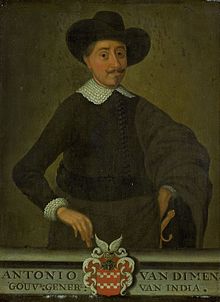Antonie van Diemen
| Anthony van Diemen | |
|---|---|

Portrait of Anthony van Diemen
|
|
| Governor-General of the Dutch East Indies | |
|
In office 1636–1645 |
|
| Preceded by | Hendrik Brouwer |
| Succeeded by | Cornelis van der Lijn |
| Personal details | |
| Born | 1593 Culemborg, Utrecht, Dutch Republic |
| Died |
19 April 1645 Batavia, Dutch East India |
| Nationality | Dutch |
| Occupation | Explorer, colonial governor |
Anthony van Diemen (also Antonie, Antonio, Anton, Antonius) (1593 – 19 April 1645) was a Dutch colonial governor.
He was born in Culemborg in the Netherlands, the son of Meeus Anthonisz van Diemen and Christina Hoevenaar. In 1616 he moved to Amsterdam, in hope of improving his fortune as a merchant; in this he failed and was declared bankrupt. After a year he became a servant of the Dutch East India Company and sailed to Batavia, Dutch East Indies (Jakarta), capital of the Dutch East Indies. On the voyage out, the East Indiaman Mauritius inadvertently put in on unknown coast of Australia.
Governor Jan Pieterszoon Coen found van Diemen to be a talented official and by 1626 he was Director-General of Commerce and member of the Council for the Indies. In 1630 he married Maria van Aelst. A year later he returned to the Netherlands as Admiral on the ship Deventer. In 1632 he returned to Batavia and in 1635 he was appointed Governor-General of the Dutch East Indies, his appointment taking effect on 1 January 1636.
Van Diemen's nine years as Governor-General were successful and important for both the colony and the commercial success of the Dutch East India Company. He devoted much of his energy to expanding the power of the company throughout South-East Asia. Under his rule Dutch power was established in Ceylon (now Sri Lanka) via Trincomalee.
Van Diemen is best remembered for his efforts to foster exploration of the "Great South Land", Australia, resulting in "the final and most ambitious Dutch voyages of the century". The first voyage under his energetic administration was undertaken within three months of his arrival in Batavia; starting from Cape York its ships were to chart the unknown coasts, but the venture ended in failure, when its commander was killed by natives in New Guinea, and the ships returned. In 1639 he commissioned two voyages to the north, in search of the "Gold and Silver Islands" that Spanish reports placed in the North Pacific to the east of Japan, and sent Maarten Gerritsz Vries to explore the coasts of Korea and "Tartaria"; these, two returned fruitlessly. Undeterred, Van Diemen appointed Frans Visscher to draw up a plan for new discoveries. Visscher mapped out three different routes and van Diemen decided in August 1642 to send Abel Janszoon Tasman, accompanied by Visscher, in search of the Great South Land, which Tasman would soon dub "Nieuw Holland".
...
Wikipedia
